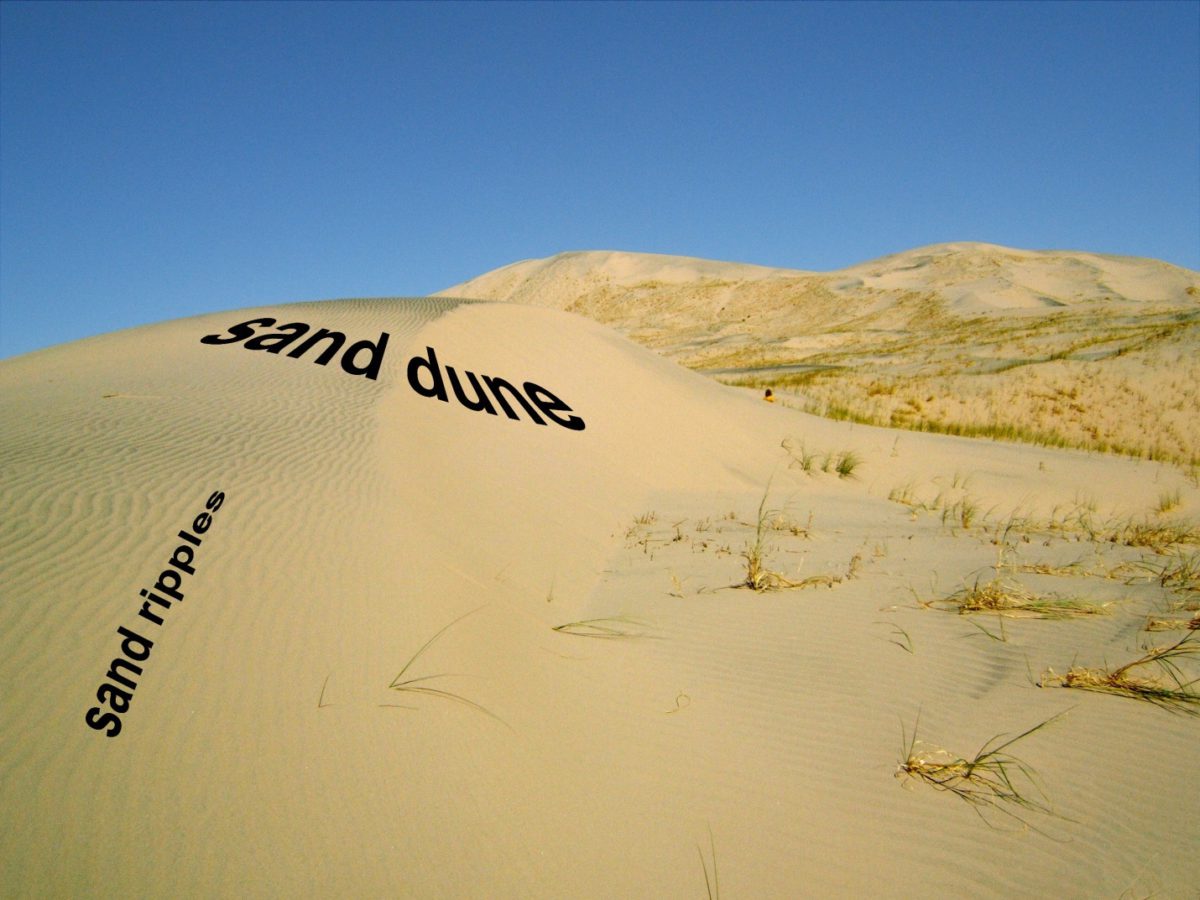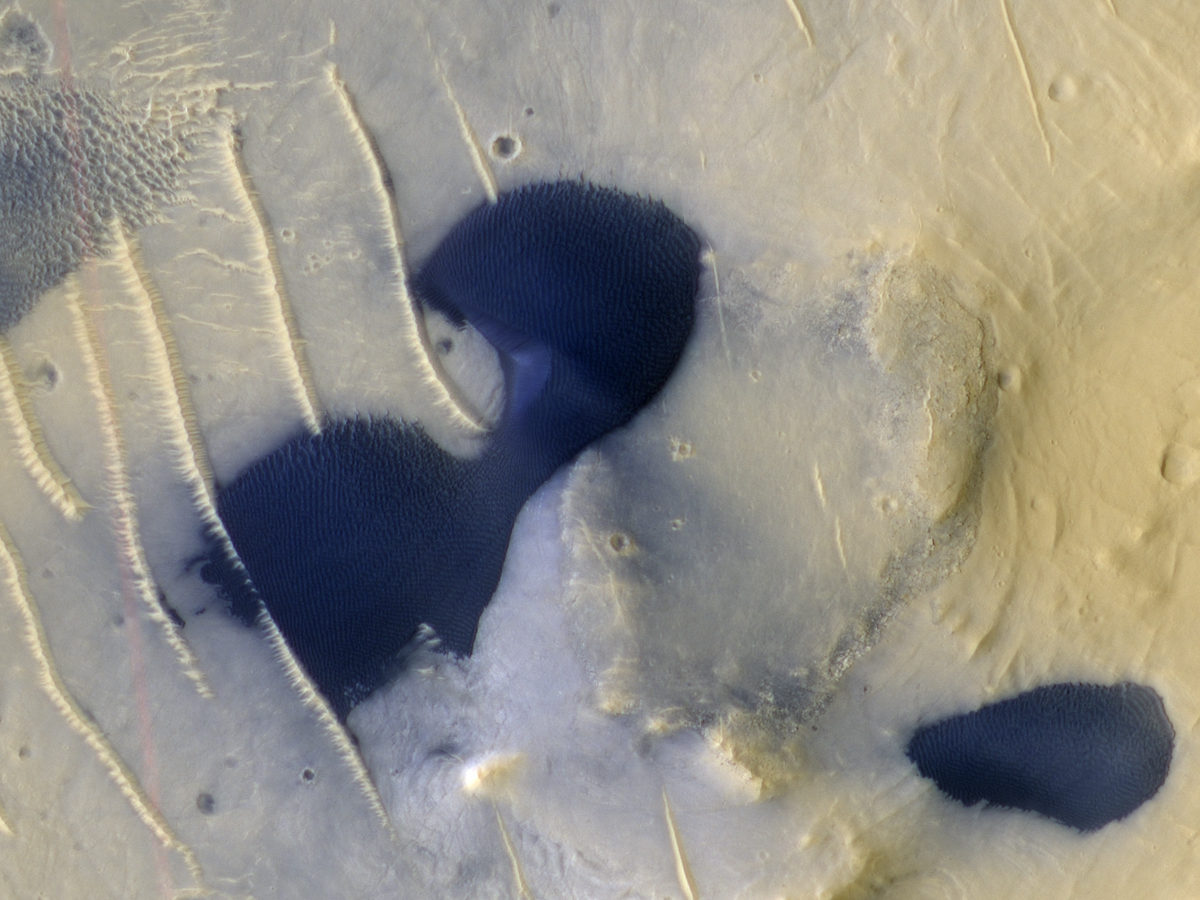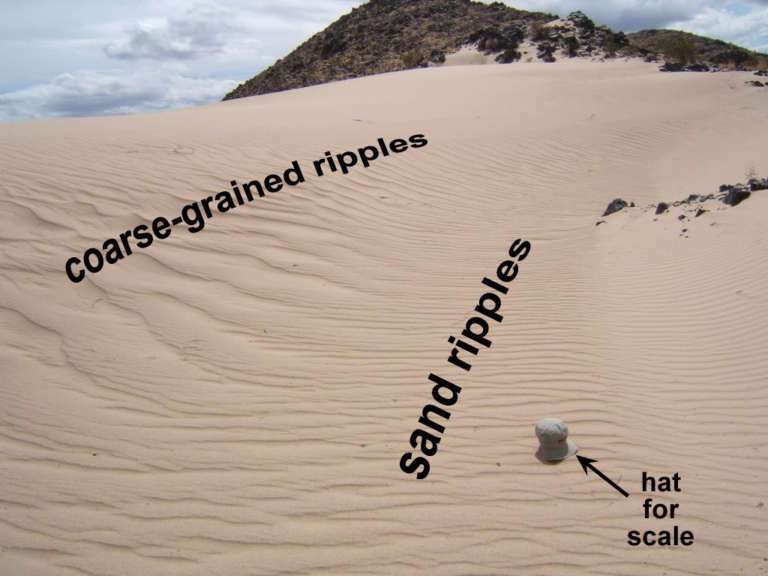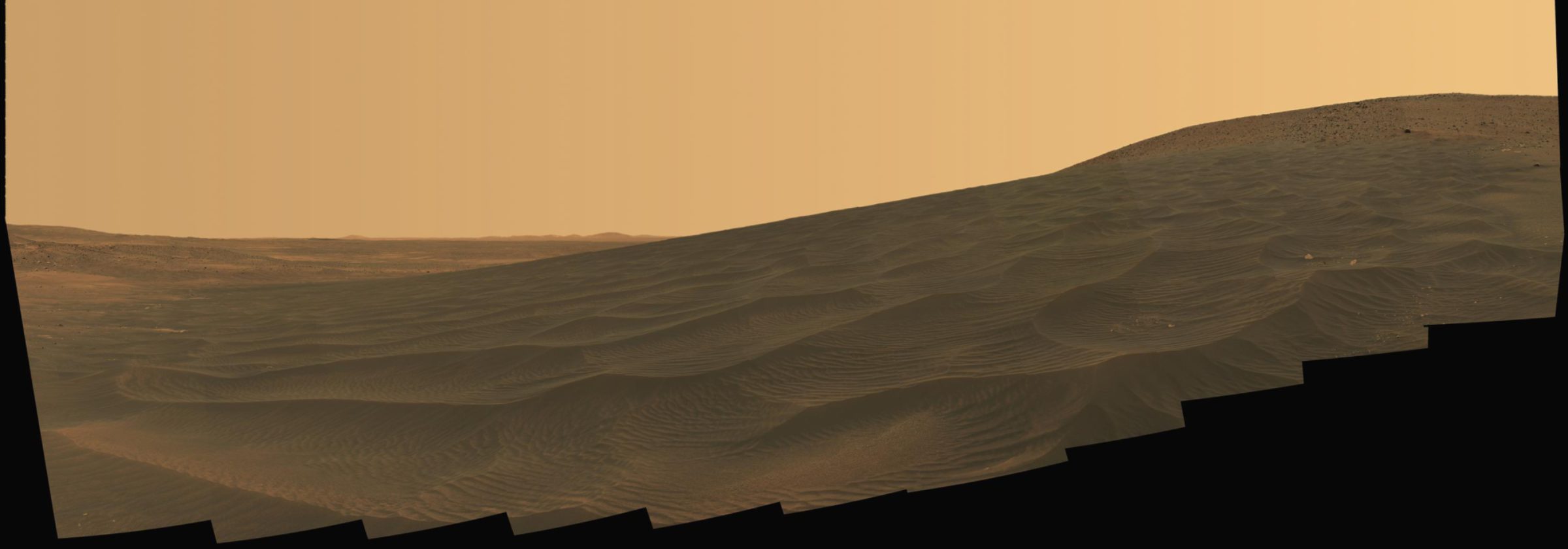Lori Fenton • Feb 21, 2014
Sand Waves in the Desert
or “Pet Peeves and Deciphering Climate Change in the Solar System”
When you picture a sand dune in your mind, you may think of grass-tufted mounds at the beach or enormous hills of sand found in extremely dry places like the Saharan deserts. When you hear the words sand ripple, you might think of much smaller things, like regularly-spaced mounds of dirt a few centimeters apart that form in street gutters after it rains. Both dunes and ripples are bedforms, which is a fancy word for “piles of stuff that form as the wind blows the stuff along the ground.”
Bedforms don’t have to be made by wind – any fluid will do. For example, there are plenty of lovely dunes at the bottoms of rivers, lakes, and oceans, all formed by moving water. The “stuff” in the bedforms can be sand or ice pellets, or anything that can be moved by a fluid. In some places (like the Altiplano in South America) the wind is strong enough to move pebbles, which are found in some of the ripples that form there.

I have a pet peeve: the words dune and ripple are often used interchangeably, although they have specific meanings and are quite distinct from one another. At least this is the case in aeolian science, which is the study of windblown materials and processes – unfortunately the terms dune and ripple have different meanings in fluvial studies. So what’s the difference between aeolian dunes and ripples? And why should anybody care?
Well, it turns out the study of aeolian bedforms is important for understanding patterns of wind flow, which are in turn important for understanding larger scale patterns of weather and climate change. This is especially the case on other bedform-covered worlds like Mars and Titan, where there are very few wind measurements. Until we can send an expensive enormous array of atmospheric sensors to these places, the patterns of dunes and ripples will serve as “wind vanes” on planetary surfaces.

Dunes
Sand dunes are the classic desert structure: picture a herd of camels and you’ll probably also imagine a dune in the background. You’ll find them anywhere there’s enough sand around that isn’t trapped by vegetation or moisture, and where the wind blows strong enough to move that sand. On Earth, dunes range in height from about 1 to 500 meters. That’s a pretty wide range!
All bedforms are created by instabilities, in which small disturbances are amplified as the wind blows over the ground. A pile of sand more than about 20 meters across affects the wind blowing above it – its height creates a disturbance in the wind that leads to an instability. Below this size, the pile of sand doesn’t affect the wind enough to create an instability, and so you’ll never see dunes smaller than about 20 meters across. Once the instability catches hold, though, the dunes can grow to be a kilometer across or more, provided there’s enough sand around and nothing stops the dune’s growth.
Large dunes are easily seen from space. Their shape and alignment are controlled by the winds that formed them, and so dunes can be used to determine the direction and relative strengths of the winds that created them. The larger the dune, the more sand it’s got in it, and so the longer it takes to respond to changes in the wind. The smallest dunes may form fresh every year, building up in one season (say, summer) and being destroyed in another (say, winter). But the biggest dunes may be thousands of years old, having been formed over a long time. These dunes tell us what wind patterns were like long ago, perhaps during the last ice age. Some dunes are buried and turn into sandstones – many of these are millions of years old and contain fossils. So not only can we tell what critters lived on those dunes when they were still being blown by the wind, we can tell what the wind patterns were like. That’s pretty awesome, if you ask me.
Ripples
Sand ripples are smaller than dunes, with widths ranging from about 1 to 20 cm. Because they are so small, a ripple doesn’t affect the wind blowing above it, and so they are not formed by the same instability that creates dunes. Ripples are a different beast altogether.
When moved by the wind, sand bounces along the ground (scientists call this saltation). If you’ve ever been on the beach in a strong wind, you’ve probably noticed this – saltating sand stings as it hits you and it gets into your hair, beach towel, and lunch. As the bouncing sand grains hit the ground, they splash into the surface, causing other grains to bounce short distances (maybe a few centimeters). Small hollows in the ground are protected from impacting sand grains, and so once grains are splashed into the lows, they stay put. Slightly higher areas “stick up” into the wind and are hit more by impacting sand grains. This is how ripples move downwind: the upwind sides slowly lose their splashed grains, while the protected downwind sides slowly fill up with splashed grains. The distance from one ripple to the next is related to the distance grains are splashed, which is in turn related to grain size and wind speed.

Good examples of ripples are found on most beaches (particularly on windy days), and on most dune surfaces. They can form quickly and disappear quickly, over a matter of minutes to hours. Ripples are useful for determining wind directions from the most recent storm. They’re good for figuring out what’s happened in the last few days, whereas dunes are good for figuring out what the wind was doing in the last year or, if it’s a big dune, the last century or millennium.
Coarse-grained ripples, megaripples, and giant ripples are different terms for the same thing: ripples that have two different sets of grains in them. One set consists of the familiar, sand-sized grains (with typical diameters of 0.1 to 1 millimeter) that bounce along the ground and form sand ripples and dunes. The other is a set of larger grains, ranging in diameter from millimeters to centimeters. Coarse-grained ripples form the same way sand ripples do, but in this case the larger grains are not easily splashed by impacting sand grains. Rather, the impacting sand grains nudge the larger, heavier grains a little bit each time (like an ant trying to move a rubber tree plant). Under the onslaught of thousands of sand grain impacts, the larger grains slowly move along the ground (scientists call this motion creep – yes, sometimes we really do use simple, sensible words).

The larger grains tend to sit on the surface of ripples, armoring them and protecting them from erosion. In fact, coarse-grained ripples have been known to trap tiny dust grains that fall out of the atmosphere on calm days – they slip into the spaces between grains and get stuck there. So a coarse-grained ripple can contain a mix of tiny to large grains, unlike the other types of bedforms.
Coarse-grained ripples are larger than regular ripples, and they are covered in large grains that are not easily moved by the wind. As a result they move more slowly than regular ripples. Recent fieldwork on Earth shows that some of these can form and then simply stop moving altogether, because the larger grains on the surface may protect the ripple so well that the wind loses its ability to move the ripple downwind.
Mars has lots of coarse-grained ripples. Most of the “dunes” visited and imaged by every lander and rover sent to Mars to date have been coarse-grained ripples. Many of these bedforms seem to be quite old: they probably formed a long time ago, but now they are immobilized by an armor of coarse grains.

There is an overlap in the size range between coarse-grained ripples and dunes: coarse-grained ripples can form with spacings up to 10 to 20 meters across, which is at the lower size range of where dunes begin to form. You can tell the difference fairly easily up close: if the surface is covered in large grains, and the interior is made mostly of finer grains, then you’re probably looking at a coarse-grained ripple. The most recent example of this was the “dune” reaching across Dingo Gap, which Curiosity drove across on Feb. 4-5, 2014. That beast is in all likelihood a coarse-grained ripple, not a dune. Sand dunes on Mars tend to be made of dark basaltic sand – Curiosity will pass very close to a field of these dunes on its way up Mt. Sharp in the coming year. I promise those images will be stunning. Dunes always are.
The Bottom Line
Dunes and ripples are both bedforms: piles of stuff that is moved along the ground by the wind (or by some fluid, like water). They are formed in different ways, taking anywhere from minutes to millennia to respond to changes in wind patterns. Centimeter-sized ripples might reflect winds from the previous hour, whereas kilometer-sized dunes might reflect wind patterns from the last ice age. Because they are visible in spacecraft images, dunes (and the largest ripples) provide some of the only clues to both recent and ancient weather patterns on the worlds where they are found. To date those worlds include Venus, Earth, Mars and Titan, but who knows? There may well be bedforms on the floor of Europa’s underground water oceans, recording the flow of its currents, or maybe there are some intriguing bedforms down deep under the thick atmospheres of Uranus and Neptune. One thing I’ve learned about planetary science is that I will always be wonderfully surprised at what we find out there.
Let’s Go Beyond The Horizon
Every success in space exploration is the result of the community of space enthusiasts, like you, who believe it is important. You can help usher in the next great era of space exploration with your gift today.
Donate Today

 Explore Worlds
Explore Worlds Find Life
Find Life Defend Earth
Defend Earth

